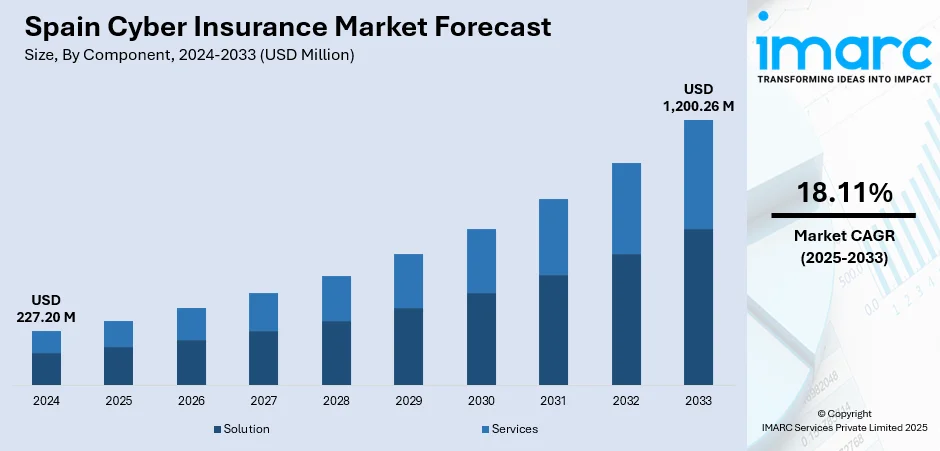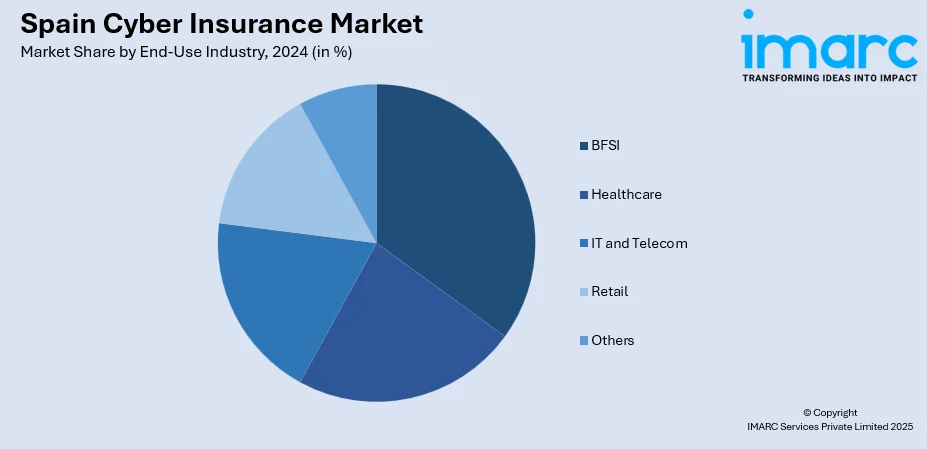
Spain Cyber Insurance Market Size, Share, Trends and Forecast by Component, Insurance Type, Organization Size, End-Use Industry, and Region, 2025-2033
Spain Cyber Insurance Market Overview:
The Spain cyber insurance market size reached USD 227.20 Million in 2024. The market is projected to reach USD 1,200.26 Million by 2033, exhibiting a growth rate (CAGR) of 18.11% during 2025-2033. The market is expanding as more businesses adopt cyber risk policies to counter increasing threats of data breaches and ransomware. Supportive regulations and integrated cybersecurity services are also helping boost Spain cyber insurance market share across both large enterprises and mid-sized firms.
|
Report Attribute
|
Key Statistics
|
|---|---|
|
Base Year
|
2024
|
|
Forecast Years
|
2025-2033
|
|
Historical Years
|
2019-2024
|
| Market Size in 2024 | USD 227.20 Million |
| Market Forecast in 2033 | USD 1,200.26 Million |
| Market Growth Rate 2025-2033 | 18.11% |
Spain Cyber Insurance Market Trends:
Mid-Sized Firms Driving Policy Uptake
A key factor shaping the Spain cyber insurance market growth is the rising interest from mid-sized companies. These firms are increasingly vulnerable to ransomware, phishing, and third-party data breaches, yet often lack internal cybersecurity expertise. Recent incidents affecting supply chains and payment systems have highlighted the cost of digital exposure, prompting more businesses in this segment to explore insurance as a financial safeguard. Regulatory enforcement of data protection rules, particularly under GDPR, has added pressure on organizations to prove they have appropriate response plans in place. Insurance policies are no longer seen just as a financial buffer, but also as part of an operational risk strategy. Providers in Spain are adapting by introducing flexible policy structures, simplified underwriting processes, and integrated services that appeal to companies with tighter budgets. Growing awareness, combined with targeted product offerings and improved digital onboarding tools, is encouraging wider participation in the market. As insurers continue to develop sector-specific coverage and support packages, mid-market adoption is expected to rise steadily.

To get more information on this market, Request Sample
Tech-Integrated Services Reshaping Coverage
Cyber insurance products in Spain are becoming increasingly connected to digital protection services. Providers now embed coverage within broader cybersecurity offerings, including continuous threat monitoring, employee security training, and incident response access. This shift is not just a marketing strategy but a response to changing client expectations. Businesses prefer coverage that includes ongoing defense tools, rather than relying only on claims after a breach. Service-based models also help insurers better assess risk and gather real-time data that supports pricing accuracy. Partnerships with managed security providers and IT consultants have expanded the delivery of these bundled solutions, making them available even to small businesses. The approach also allows insurers to offer risk prevention advice backed by technical insight, rather than relying solely on historical loss data. As cyber threats grow more complex, this blend of insurance and service continues to gain traction. Market participants focusing on collaboration, technical support, and data-informed customization are better positioned to retain clients and lower their own exposure.
Spain Cyber Insurance Market Segmentation:
IMARC Group provides an analysis of the key trends in each segment of the market, along with forecasts at the country and regional level for 2025-2033. Our report has categorized the market based on component, insurance type, organization size, and end-use industry.
Component Insights:
- Solution
- Services
The report has provided a detailed breakup and analysis of the market based on the component. This includes solution and services.
Insurance Type Insights:
- Packaged
- Stand-alone
The report has provided a detailed breakup and analysis of the market based on the insurance type. This includes packaged and stand-alone.
Organization Size Insights:
- Small and Medium Enterprises
- Large Enterprises
The report has provided a detailed breakup and analysis of the market based on the organization size. This includes small and medium enterprises and large enterprises.
End-Use Industry Insights:

- BFSI
- Healthcare
- IT and Telecom
- Retail
- Others
The report has provided a detailed breakup and analysis of the market based on the end-use industry. This includes BFSI, healthcare, IT and telecom, retail, and others.
Regional Insights:
- Northern Spain
- Eastern Spain
- Southern Spain
- Central Spain
The report has also provided a comprehensive analysis of all the major regional markets, which include Northern Spain, Eastern Spain, Southern Spain, and Central Spain.
Competitive Landscape:
The market research report has also provided a comprehensive analysis of the competitive landscape. Competitive analysis such as market structure, key player positioning, top winning strategies, competitive dashboard, and company evaluation quadrant has been covered in the report. Also, detailed profiles of all major companies have been provided.
Spain Cyber Insurance Market News:
- Jue 2025: HBX Group partnered with Wallbid to launch Cybersential, a cyber risk assessment service for hotels in Europe. Targeting Spain’s hospitality sector, it enhanced cyber readiness and supported cyber insurance uptake by identifying vulnerabilities and aligning with stricter data protection regulations.
- June 2025: Marsh launched Cyber Unity across the EU, including Spain, offering up to €5 Million in cyber insurance coverage for mid-sized firms. The initiative improved access to tailored protection, strengthened incident response capabilities, and helped close coverage gaps in Spain’s growing cyber insurance market.
Spain Cyber Insurance Market Report Coverage:
| Report Features | Details |
|---|---|
| Base Year of the Analysis | 2024 |
| Historical Period | 2019-2024 |
| Forecast Period | 2025-2033 |
| Units | Million USD |
| Scope of the Report |
Exploration of Historical Trends and Market Outlook, Industry Catalysts and Challenges, Segment-Wise Historical and Future Market Assessment:
|
| Components Covered | Solution, Services |
| Insurance Types Covered | Packaged, Stand-alone |
| Organization Sizes Covered | Small and Medium Enterprises, Large Enterprises |
| End-Use Industries Covered | BFSI, Healthcare, IT and Telecom, Retail, Others |
| Regions Covered | Northern Spain, Eastern Spain, Southern Spain, Central Spain |
| Customization Scope | 10% Free Customization |
| Post-Sale Analyst Support | 10-12 Weeks |
| Delivery Format | PDF and Excel through Email (We can also provide the editable version of the report in PPT/Word format on special request) |
Key Questions Answered in This Report:
- How has the Spain cyber insurance market performed so far and how will it perform in the coming years?
- What is the breakup of the Spain cyber insurance market on the basis of component?
- What is the breakup of the Spain cyber insurance market on the basis of insurance type?
- What is the breakup of the Spain cyber insurance market on the basis of organization size?
- What is the breakup of the Spain cyber insurance market on the basis of end-use industry?
- What is the breakup of the Spain cyber insurance market on the basis of region?
- What are the various stages in the value chain of the Spain cyber insurance market?
- What are the key driving factors and challenges in the Spain cyber insurance market?
- What is the structure of the Spain cyber insurance market and who are the key players?
- What is the degree of competition in the Spain cyber insurance market?
Key Benefits for Stakeholders:
- IMARC’s industry report offers a comprehensive quantitative analysis of various market segments, historical and current market trends, market forecasts, and dynamics of the Spain cyber insurance market from 2019-2033.
- The research report provides the latest information on the market drivers, challenges, and opportunities in the Spain cyber insurance market.
- Porter's Five Forces analysis assists stakeholders in assessing the impact of new entrants, competitive rivalry, supplier power, buyer power, and the threat of substitution. It helps stakeholders to analyze the level of competition within the Spain cyber insurance industry and its attractiveness.
- Competitive landscape allows stakeholders to understand their competitive environment and provides an insight into the current positions of key players in the market.
Need more help?
- Speak to our experienced analysts for insights on the current market scenarios.
- Include additional segments and countries to customize the report as per your requirement.
- Gain an unparalleled competitive advantage in your domain by understanding how to utilize the report and positively impacting your operations and revenue.
- For further assistance, please connect with our analysts.
 Request Customization
Request Customization
 Speak to an Analyst
Speak to an Analyst
 Request Brochure
Request Brochure
 Inquire Before Buying
Inquire Before Buying




.webp)




.webp)












